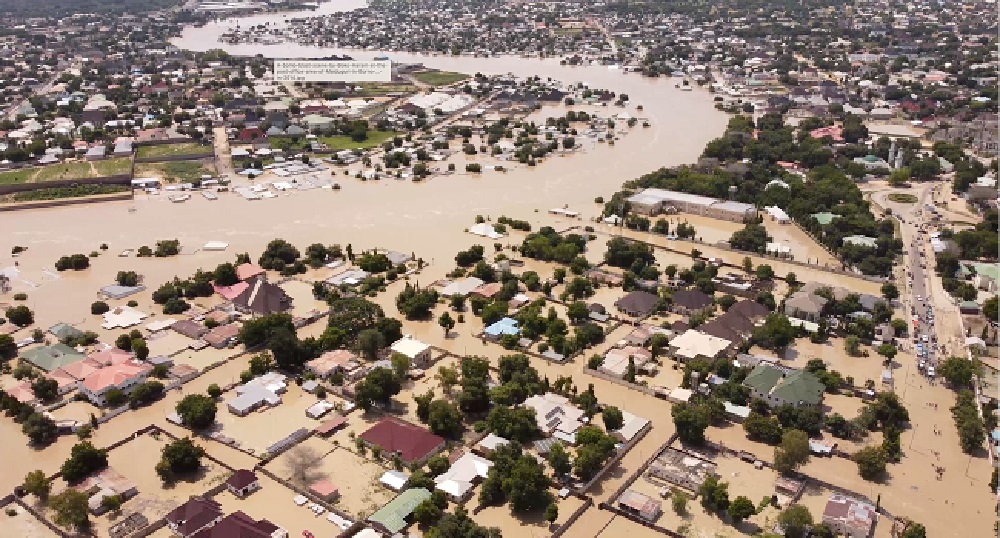News
Borno: Evacuation of corpses, trapped persons begins in Maduguri after floods

Thousands of families trapped in Maiduguri flooded areas are being evacuated to safer areas by the military, volunteers and other security agencies.
Visiting the most affected areas in Maiduguri, the Minister of Interior, Olubunmi Tunji-Ojo, toured through the Customs area where the broken prison is located.
While on the tour, dead bodies were also being evacuated. Trapped persons were also being evacuated by the military, security agencies and civilian volunteers.
Although some flooded areas of Maiduguri have receded, badly affected areas like Gamboru Market, Kasuwan Shanu, Custom Area, Fori, and Abbaganaram are actively flooded.
The premises of the Nigerian prisons is still being flooded while public infrastructure, amenities, shops and vehicles are completely submerged by the flood.
Women, children and vulnerable persons are mostly those trapped and being evacuated.
In the entourage of the Minister are the Controller-Generals of Immigration, Correctional Service and the Secretary of Civil Defence, Correctional, Fire and Immigration Services Board.
Several aerial videos and photos shared by the National Emergency Management Agency (NEMA) with AFP showed rows of houses submerged in murky water.
Maiduguri, an epicentre of more than a decade-long jihadist insurgency, serves as the hub for the responses to the humanitarian crisis in the northeast region.
The United Nations refugee agency in Nigeria (UNHCR) on its X account said it was the city’s worst flooding in 30 years.
“It is an unprecedented incident,” NEMA spokesman Ezekiel Manzo told AFP on Tuesday. “Some of the central parts of the city that have not witnessed flood in so many years are witnessing it today.”
Thousands of homes have been submerged by the rapid rise of waters after the rupture of the Alau dam on the Ngadda River, 20 kilometres (12 miles) south of Maiduguri.
“The last three days have over 150,000 individuals with over 23,000 households affected,” said NEMA zonal coordinator Surajo Garba.
But with more locations being hit, “we are sure the figure will be much over 200,000 individuals,” Garba forecast.
“The flood, which began over the weekend and worsened in the following days, was the direct result of excess water from the Alau Dam,” said Nigeria’s Vice-President Kashim Shettima, who hails from Maiduguri as he visited the area.
“The collapse of the spillways unleashed a significant surge of water downstream, causing widespread flooding in the surrounding communities,” added Shettima.
The flood also inundated the city’s post office and main zoo, with authorities warning that “deadly animals has been washed away into our communities (sic).”
Social media showed pictures of an ostrich which had supposedly escaped from the facility wandering the streets of the city.
News
Nnamdi Kanu’s family wants court to ban NAN coverage of son’s trial or allow live streaming

By Kayode Sanni-Arewa
The family of Nnamdi Kanu has again demanded an outright ban of the News Agency of Nigeria, NAN from coverage of Kanu’s trial on alleged terrorism related crimes over alleged biased reportage.
In the alternative, the aggrieved family asked the court to permit live streaming of trial proceedings to guarantee fairness, transparency and accountability.
A statement signed by Prince Emmanuel Kanu for the Kanu Family, expressed the family “deep concern and outrage over what it called the continuous shameless manipulation of court proceedings by the News Agency of Nigeria (NAN) in the ongoing trial of their son and brother, Mazi Nnamdi Kanu.”
“It is now beyond question that NAN has abandoned any pretense of professional journalism. They have become the unofficial megaphone of the State Security Services (SSS) and the prosecuting authority, spreading one-sided propaganda, while deliberately ignoring crucial courtroom developments that dismantle the Government’s case.
“Today’s distortion is a case in point. Instead of reporting on the damning cross-examination of government witness PW-BBB—who embarrassingly admitted that no investigation report exists to support the charges against Mazi Nnamdi Kanu, NAN chose to publish a useless story about a death certificate.
This document has zero evidentiary relevance, and its tendering was clearly a diversionary tactic to cover up the implosion of the prosecution’s case.
See also Ministerial appointment: Ignore detractors and clear Ondo nominee, groups urge Senate
“We find it unacceptable and improper that NAN is given exclusive access to report court proceedings—particularly when their reports serve only to mislead the public and undermine judicial transparency.
“We therefore call on Justice James Omotosho to immediately ban the News Agency of Nigeria (NAN) from further courtroom access in this matter for repeated, unethical conduct and biased reporting;
” In the alternative, the court should permit live streaming of the trial proceedings to guarantee fairness, transparency, and accountability.
“Furthermore, we reject the spin being spread regarding DSS allegedly denying Kanu Agabi SAN access to Mazi Nnamdi Kanu.
What occurred in court today was a moment of statesmanship by Kanu Agabi SAN—a respected legal elder, former Senator, Attorney-General, and Minister of Justice—who chose not to expose the DSS’s misconduct openly to save the court and its officers from scandal. His restraint should not be misrepresented by a discredited press agency.
“This trial is not just about Mazi Nnamdi Kanu—it is a test of the integrity of the Nigerian judiciary, the independence of the media, and the rule of law in a democracy. Continued distortion of proceedings can only serve to deepen national division and erode public trust.
The eyes of the world are on Nigeria. Let justice be done—openly and without propaganda” the family said.
News
NFIU denies link to BNBEX, warns public against fake circular

The Nigerian Financial Intelligence Unit (NFIU) has distanced itself from a platform known as BNBEX and disowned a circular that falsely claims the unit is reviewing transactions of Nigerian users on the platform.
In a statement released on Wednesday and signed by Sani Tukur, Head of the Strategic Communications Department at the NFIU, the agency made it clear that it has no connection with BNBEX, has not validated its operations, and has not initiated or approved any compliance exercise related to the platform.
“The circular was not issued by the NFIU and bears no connection whatsoever to any of the Unit’s current regulatory or compliance initiatives,” the statement read.
The Unit also refuted the existence of any regulation titled “Nigerian Financial Surveillance Regulation,” which was cited in the document circulated by BNBEX. According to the NFIU, no such regulation exists within Nigeria’s legal or financial regulatory framework.
The circular, which was posted on BNBEX’s website, falsely alleged that the NFIU was conducting a compliance review involving all transactions carried out by Nigerians on the platform. The NFIU categorically rejected this claim and described the document as fake and misleading.
The agency further clarified that the logo and insignia used in the controversial document do not belong to the NFIU. It described them as fabricated and cautioned the public against accepting such materials as legitimate.
With regards to location, the NFIU stated that it has no offices in the Central Business District of Abuja or any other area outside of its official headquarters located at No. 1 Monrovia Street, Wuse II, Abuja.
The Unit then urged members of the public to be vigilant and verify information through official NFIU channels to avoid falling victim to scams or disinformation.
“For purposes of clarification or to report suspicious information purporting to be from the NFIU, please contact the Strategic Communications Department at [email protected],” the statement concluded.
The NFIU serves as Nigeria’s central national agency responsible for the receipt and analysis of financial disclosures concerning suspected proceeds of crime and other financial information to combat money laundering, terrorism financing, and related crimes.
This latest development shows the increasing challenges of financial fraud in Nigeria’s digital space and the need for the public to be cautious when dealing with online platforms, especially those making claims involving regulatory agencies and promising mouth-watering returns on investments.
News
NAHCON airlifts 14,165 pilgrims in five days

The National Hajj Commission of Nigeria (NAHCON) said it has airlifted 14,165 pilgrims in five days.
This, the commission said, represents 34.4 per cent of the total pilgrims for this year’s edition.
A statement by Assistant Director, Information and Publication, Fatima Sanda Usara, said the figure is an improvement from last year’s 20.2 per cent of pilgrims with 23 flights transported 9, 788 pilgrims.
She listed the States that have concluded their airlift to include Oyo, Abia, Kogi, and Nasarawa States.
Meanwhile, Ondo and Ekiti States are preparing for their final flights, which will be undertaken as a combined airlift.
The commission said: “Importantly, no flight cancellations have been recorded so far. On the contrary, one of the carriers transporting pilgrims from Niger State arrived in Saudi Arabia earlier than expected as a mark of diligence. The commission commended its staff for their prompt action and being up to task.
“NAHCON attributes the continued success of the airlift operations to the full cooperation from the State Pilgrims’ Boards, and the wisdom in engaging four airlines for this year’s airlift. The air carriers have been doing their best to fulfill the terms of engagement they signed with NAHCON. “Additionally, Saudi Arabian authorities have released full flight schedules to all participating airlines, which further facilitates proper planning and timeliness. All flights are currently landing in Madinah, in line with the agreed plan.”
She said the first set of pilgrims that arrived the Kingdom are now in Makkah to commence their Umrah for those who select Hajj Tumattu’i or Qiran.”
-

 News21 hours ago
News21 hours agoJust in: FG receives Wigwe’s helicopter crash report from NTSB
-

 Entertainment22 hours ago
Entertainment22 hours agoSAD ! Popular Nollywood actress, Monalisa Stephen is dead
-

 News21 hours ago
News21 hours agoJust in: Tinubu’s son Seyi, Tops Controversial List As Lagos Guber Race Ignites Political Wahala
-

 News24 hours ago
News24 hours agoPDP headache: Saraki’s Cttee signals there’s genuine intention to reconcile and resolve knotty issues -Hon Teejay Yusuf
-

 News6 hours ago
News6 hours agoNNPCL failed to remit N500bn revenue in 2024 – World Bank
-

 News7 hours ago
News7 hours agoTinubu Endorses Establishment of Forest Guards to Counter Terrorism, Banditry
-

 Education17 hours ago
Education17 hours agoJust in: JAMB orders UTME resit for 387,000 candidates
-

 Opinion21 hours ago
Opinion21 hours agoODA, ODI RALLY AGAINST INSECURITY IN OKUNLAND






